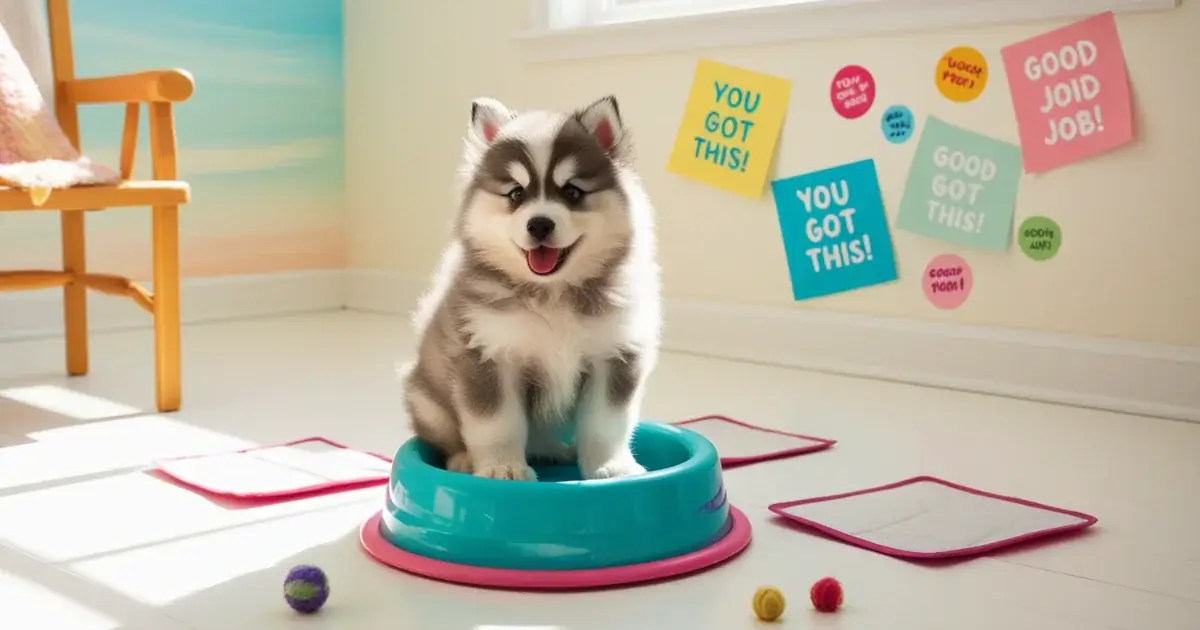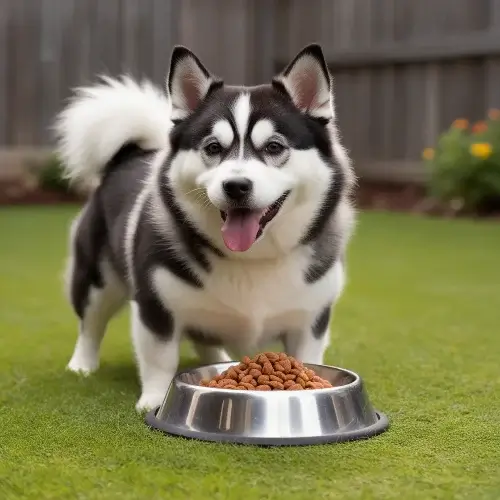What’s the Fastest Way to Potty Train a Pomsky?

Potty training a Pomsky can seem challenging, but with the right approach, it’s achievable and rewarding. Pomskies are intelligent, but their mixed Husky and Pomeranian traits can make them a bit stubborn. With patience, consistency, and a clear plan, you can successfully housebreak your Pomsky and establish good habits.
Here’s my guide based on my experience and proven methods to help you potty train a Pomsky efficiently.
Table of Contents
Importance of a Consistent Schedule for Pomsky Potty Training
Pomskies thrive on structure. Establishing a consistent potty training schedule helps your puppy understand when to eat, drink, and go outside. This is the foundation for successful potty training.
Feeding Your Pomsky on a Schedule
Feeding your Pomsky at regular times each day is critical. Give them 10–15 minutes to eat, then remove any uneaten food. This prevents grazing and helps you predict when they’ll need a potty break. Avoid free-feeding as it makes house training difficult and leads to health issues.

“A feeding schedule not only helps with potty training but also keeps my Pomsky healthy and energetic.”
| Do’s | Don’ts |
| Feed at regular times. | Avoid leaving food out. |
| Remove uneaten food promptly. | Don’t allow grazing habits. |
Timing Potty Breaks After Meals and Naps
Take your Pomsky outside about 10 minutes after meals and right after naps. Additionally, schedule breaks:
- First thing in the morning
- Last thing at night
- Every 2–3 hours during the day
“Timing is everything. A predictable routine helps your Pomsky associate meals and naps with outdoor potty trips.”
Avoiding Water Restrictions
Unlike food, water should always be available. Some believe restricting water helps prevent accidents, but this is a myth. Always provide fresh water for your Pomsky to keep them healthy. Thirsty dogs often overdrink, leading to more accidents.
Using a Crate Effectively for Potty Training
Crate training is one of the most effective methods to housebreak a Pomsky. Used properly, a crate helps your dog develop bladder and bowel control. It also provides a safe, cozy space for your puppy.
Choosing the Right Crate
Select a crate that’s just the right size—large enough for your Pomsky to stand, turn, and lie down, but not so large that they can eliminate in one corner.
“A well-sized crate is like a bedroom for your Pomsky—it keeps them safe and helps them learn good habits.”
| Features to Look For | Why It’s Important |
| Correct size | Prevents elimination in the crate. |
| Comfortable bedding | Helps your puppy feel secure. |
Teaching Bladder and Bowel Control
If your Pomsky doesn’t eliminate during a potty break, place them in the crate for 10–15 minutes, then try again. Dogs avoid soiling their sleeping area, so this teaches control. However, avoid over-crating—it can lead to stress and behavior issues.
Creating a Routine for Outdoor Potty Success
A consistent outdoor potty routine is essential for training success. It helps your Pomsky associate outdoor trips with potty time.
Taking Your Pomsky to the Same Spot
Use a leash to guide your Pomsky to the same potty spot each time. This consistency helps them understand where to go. Avoid walking around too much or using unnecessary verbal commands that may confuse your puppy.
“Standing still in the same spot with my Pomsky on a leash reduced distractions and sped up training.”
Using Rewards to Reinforce Behavior
Praise and reward your Pomsky immediately after they eliminate outside. Use treats and excited tones to show them they’ve done well. Always reward them outdoors, not after coming back inside, to strengthen the association.
Recognizing Signs of Needing to Go
Watch for signs like sniffing, circling, or wandering off. These indicate your Pomsky may need a potty break. Acting quickly can prevent accidents.
Handling Accidents and Cleaning Up Properly
Accidents happen, especially in the early stages of training. How you handle them affects your Pomsky’s progress.
Responding Calmly to Accidents
Never yell or punish your Pomsky for accidents. This can cause fear and confusion. Instead, calmly guide them outside and reward them for eliminating there.
“Staying calm during accidents helped build trust and made training smoother.”
Cleaning Messes Thoroughly
Clean any accidents inside with an enzymatic cleaner to remove odors completely. Regular cleaners won’t eliminate the scent, which may encourage your Pomsky to return to the same spot.
Adapting Potty Training to Pomsky’s Unique Traits
Pomskies are unique, and training them may require extra effort. Understanding their traits helps you tailor your approach.

Understanding Pomsky Intelligence and Stubbornness
Pomskies are intelligent but can be stubborn due to their Husky lineage. This means they may take longer to learn commands. Positive reinforcement and patience are key.
“I embraced my Pomsky’s independent streak and turned training into a fun challenge.”
Breed-Specific Challenges and Tips
Some breeds are naturally more challenging to potty train. With consistent effort and rewards, even the most stubborn Pomskies can learn.
The Role of Patience and Consistency in Training
Patience and consistency are the cornerstones of potty training a Pomsky. Your puppy looks to you for guidance, so staying calm and persistent will help them succeed.
Aligning Training Methods Across Family Members
If multiple people are involved in training, ensure everyone follows the same routine. Mixed signals confuse your Pomsky and delay progress.
Building Trust and Encouraging Your Pomsky
Always treat your Pomsky with kindness and encouragement. Celebrate small successes to keep them motivated.
“Pomskies want to please their owners, so consistent encouragement goes a long way.”
Final Thoughts on Potty Training Your Pomsky
Potty training a Pomsky takes effort, but the rewards are worth it. By establishing a schedule, using a crate effectively, and staying patient, you can create lasting habits.
“Training your Pomsky is a journey, not a race. With love and consistency, you’ll build a strong bond and a well-trained pup.”
By following these Pomsky potty training tips, you’ll set your puppy up for success. Remember, the fastest way to potty train a Pomsky is with patience, consistency, and positive reinforcement.
FAQs
What is the best schedule for training a Pomsky puppy?
The best schedule for training a Pomsky puppy includes potty breaks first thing in the morning, after meals, naps, and playtime, every 2–3 hours, and before bedtime. Consistency is key for success.
Can Pomskies be housebroken faster with crate training?
Yes, crate training helps housebreaking a Pomsky puppy by teaching bladder control and providing a safe space. Ensure the crate is the right size and avoid over-crating to keep your Pomsky comfortable.
What should I do if my Pomsky has frequent accidents indoors?
Frequent accidents can indicate the need for a stricter schedule or better observation of your Pomsky’s signals. Clean accidents thoroughly to prevent re-marking and reinforce positive behaviors with treats and praise.
Are some Pomskies harder to potty train than others?
Yes, temperament and breed traits influence training ease. Some Pomskies may need more patience, especially if they inherit the Husky’s stubbornness. Following Pomsky potty training tips with consistency helps overcome these challenges.






